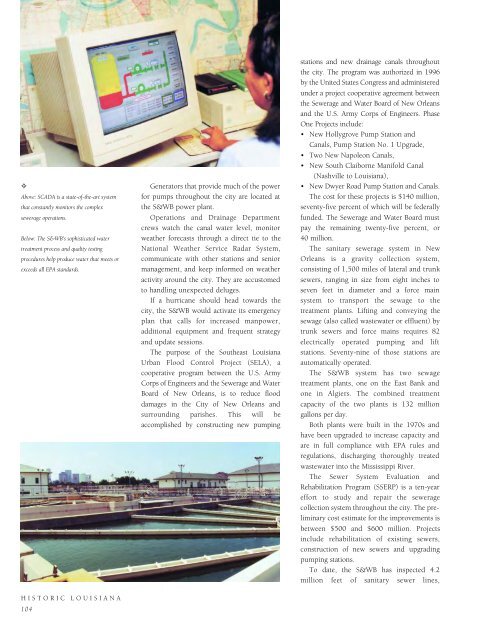Historic Louisiana
An illustrated history of Louisiana, paired with the histories of companies, families and organizations that make the state great.
An illustrated history of Louisiana, paired with the histories of companies, families and organizations that make the state great.
Create successful ePaper yourself
Turn your PDF publications into a flip-book with our unique Google optimized e-Paper software.
✧<br />
Above: SCADA is a state-of-the-art system<br />
that constantly monitors the complex<br />
sewerage operations.<br />
Below: The S&WB’s sophisticated water<br />
treatment process and quality testing<br />
procedures help produce water that meets or<br />
exceeds all EPA standards.<br />
HISTORIC LOUISIANA<br />
104<br />
Generators that provide much of the power<br />
for pumps throughout the city are located at<br />
the S&WB power plant.<br />
Operations and Drainage Department<br />
crews watch the canal water level, monitor<br />
weather forecasts through a direct tie to the<br />
National Weather Service Radar System,<br />
communicate with other stations and senior<br />
management, and keep informed on weather<br />
activity around the city. They are accustomed<br />
to handling unexpected deluges.<br />
If a hurricane should head towards the<br />
city, the S&WB would activate its emergency<br />
plan that calls for increased manpower,<br />
additional equipment and frequent strategy<br />
and update sessions.<br />
The purpose of the Southeast <strong>Louisiana</strong><br />
Urban Flood Control Project (SELA), a<br />
cooperative program between the U.S. Army<br />
Corps of Engineers and the Sewerage and Water<br />
Board of New Orleans, is to reduce flood<br />
damages in the City of New Orleans and<br />
surrounding parishes. This will be<br />
accomplished by constructing new pumping<br />
stations and new drainage canals throughout<br />
the city. The program was authorized in 1996<br />
by the United States Congress and administered<br />
under a project cooperative agreement between<br />
the Sewerage and Water Board of New Orleans<br />
and the U.S. Army Corps of Engineers. Phase<br />
One Projects include:<br />
• New Hollygrove Pump Station and<br />
Canals, Pump Station No. 1 Upgrade,<br />
• Two New Napoleon Canals,<br />
• New South Claiborne Manifold Canal<br />
(Nashville to <strong>Louisiana</strong>),<br />
• New Dwyer Road Pump Station and Canals.<br />
The cost for these projects is $140 million,<br />
seventy-five percent of which will be federally<br />
funded. The Sewerage and Water Board must<br />
pay the remaining twenty-five percent, or<br />
40 million.<br />
The sanitary sewerage system in New<br />
Orleans is a gravity collection system,<br />
consisting of 1,500 miles of lateral and trunk<br />
sewers, ranging in size from eight inches to<br />
seven feet in diameter and a force main<br />
system to transport the sewage to the<br />
treatment plants. Lifting and conveying the<br />
sewage (also called wastewater or effluent) by<br />
trunk sewers and force mains requires 82<br />
electrically operated pumping and lift<br />
stations. Seventy-nine of those stations are<br />
automatically operated.<br />
The S&WB system has two sewage<br />
treatment plants, one on the East Bank and<br />
one in Algiers. The combined treatment<br />
capacity of the two plants is 132 million<br />
gallons per day.<br />
Both plants were built in the 1970s and<br />
have been upgraded to increase capacity and<br />
are in full compliance with EPA rules and<br />
regulations, discharging thoroughly treated<br />
wastewater into the Mississippi River.<br />
The Sewer System Evaluation and<br />
Rehabilitation Program (SSERP) is a ten-year<br />
effort to study and repair the sewerage<br />
collection system throughout the city. The preliminary<br />
cost estimate for the improvements is<br />
between $500 and $600 million. Projects<br />
include rehabilitation of existing sewers,<br />
construction of new sewers and upgrading<br />
pumping stations.<br />
To date, the S&WB has inspected 4.2<br />
million feet of sanitary sewer lines,
















